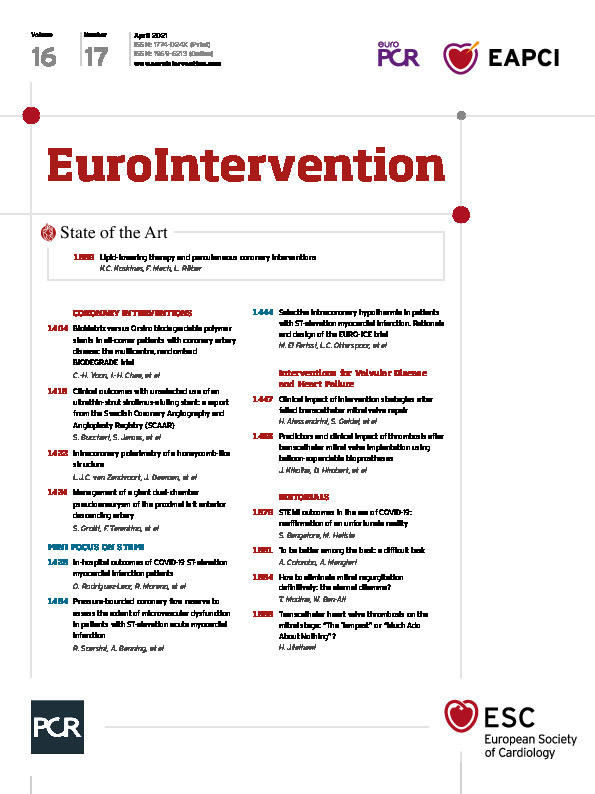
One half of the patients with severe symptomatic mitral regurgitation (MR) are not referred for surgery, due either to frailty, multiple comorbidities, or prohibitively high surgical risk1,2. The mortality rate in this cohort of patients reaches 50% at five years of follow-up, and up to 90% of surviving patients require hospitalisation for heart failure within five years after the diagnosis of severe MR1,2. In recent years, transcatheter mitral valve repair (TMVr) using the MitraClip® device (Abbott Vascular, Santa Clara, CA, USA) has become a valid and prevalent therapeutic option in patients who are inoperable or deemed to be at high surgical risk3,4. Although durable MR reduction with the MitraClip has been shown with a failure rate ranging between 1.5% and 3% in high-volume centre registries3,5, residual moderate or severe MR rates of up to 10% have been reported in a large meta-analysis of real-world patients undergoing TMVr6 with a strong prognostic impact7. Reintervention after failed TMVr is increasingly performed; however, the choice of the optimal approach can be challenging. On the one hand, surgical risk in MitraClip candidates is high before MitraClip intervention and a failed TMVr may further increase the hazard for intraoperative complications, postoperative morbidity and mortality (13.4% at 30 days in the CUTTING-EDGE registry8). On the other hand, if a reclipping approach seems to be safer due to limited invasiveness, it can be challenging from a technical point of view compared to the initial procedure with no optimal grasping site available, abnormal stress on the valve during grasping and higher risk of mitral stenosis.
In the current issue of EuroIntervention, Alessandrini et al9 have to be congratulated for their timely single-centre study reporting the outcomes of different approaches to handling failed TMVr.
The authors support the idea that reclipping remains an appropriate treatment option after failed TMVr, especially in patients with functional MR (FMR). Nonetheless, the success rate was quite disappointing, reflecting the technical challenges encountered during reclipping. The 30-day mortality rate was almost comparable to that reported in the surgical group and was somewhat high for a procedure reputed to be safe and less invasive than surgery. They also favoured a surgical approach for patients with degenerative MR (DMR), with no hospital death reported. All surgical deaths were reported in the FMR patients, patients with more comorbidities and poorer left ventricular function. TMVr or other transcatheter approaches such as transcatheter mitral valve replacement (TMVR) have to be favoured in this subset of patients. Recently, Lisko et al10 reported that TMVR after failed TMVr was feasible and safe at 30 days with optimal MR elimination and high procedural success. Mechanisms of relapsing MR were various in this study but were dominated by leaflet tear and single leaflet device attachment. This finding raises a very interesting discussion on the selection process. Despite the fact that complex mitral anatomies can be successfully treated with the MitraClip by expert operators, TMVR has the advantage over TMVr in that it is suitable for a wide range of mitral valve anatomies, including patients considered anatomically unsuitable for TMVr achieving durable MR elimination11. Finally, the authors report predictive prognostic factors of long-term death. From a statistical point of view, there were few events to run such an analysis with a robust statistical approach. Therefore, conclusions drawn from this analysis have to be handled with caution. This opens the door for a multicentric initiative to collect data on this subset of patients.
Conflict of interest statement
T. Modine is a consultant for Boston Scientific, Medtronic, Edwards, MicroPort, GE, and Abbott, and has received a research support grant from Edwards. W. Ben-Ali has no conflicts of interest to declare.
Supplementary data
To read the full content of this article, please download the PDF.

